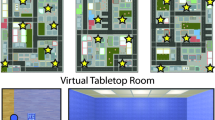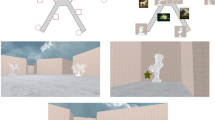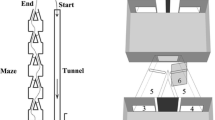Abstract
These experiments investigated how chimpanzees learn to navigate visual fingermazes presented on a touch monitor. The aim was to determine whether training the subjects to solve several different mazes would establish a generalized map-reading skill such that they would solve new mazes correctly on the first presentation. In experiment 1, two captive adult female chimpanzees were trained to move a visual object (a ball) with a finger over the monitor surface toward a target through a grid of obstacles that formed a maze. The task was fully automated with storage of movement paths on individual trials. Training progressed from very simple mazes with one obstacle to complex mazes with several obstacles. The subjects learned to move the ball to the target in a curved path so as to avoid obstacles and blind alleys. After training on several mazes, both subjects developed a high level of efficiency in moving the ball to the target in a path that closely approached the ideal shortest path. New mazes were then presented to determine whether the subjects had acquired a more generalized maze-solving performance. The subjects solved 65–100% of the new mazes the first time they were presented by moving the ball around obstacles to the target without making detours into blind alleys. In experiment 2, one of the chimpanzees was trained using mazes with two routes to the target. One of the routes was blocked at one of many possible locations. After training to avoid the blind alley in different mazes, new mazes were presented that also had one route blocked. The subject correctly solved 90.7% of the novel mazes. When the mazes had one short and one long open route to the target the subject preferred the shorter route. When the short route was blocked, the subject solved only 53.3% of the mazes because of the preference for the shorter route even when blocked. The overall results suggest that with the training methods used the subjects learned to solve specific mazes with a trial-and-error method. Although both subjects were able to solve many of the novel mazes they did not fully develop a more general "map-reading" skill.
Similar content being viewed by others
Author information
Authors and Affiliations
Additional information
Accepted after revision: 30 July 2001
Electronic Publication
Rights and permissions
About this article
Cite this article
Iversen, I.H., Matsuzawa, T. Acquisition of navigation by chimpanzees (Pan troglodytes) in an automated fingermaze task. Anim.Cogn. 4, 179–192 (2001). https://doi.org/10.1007/s100710100101
Received:
Published:
Issue Date:
DOI: https://doi.org/10.1007/s100710100101




